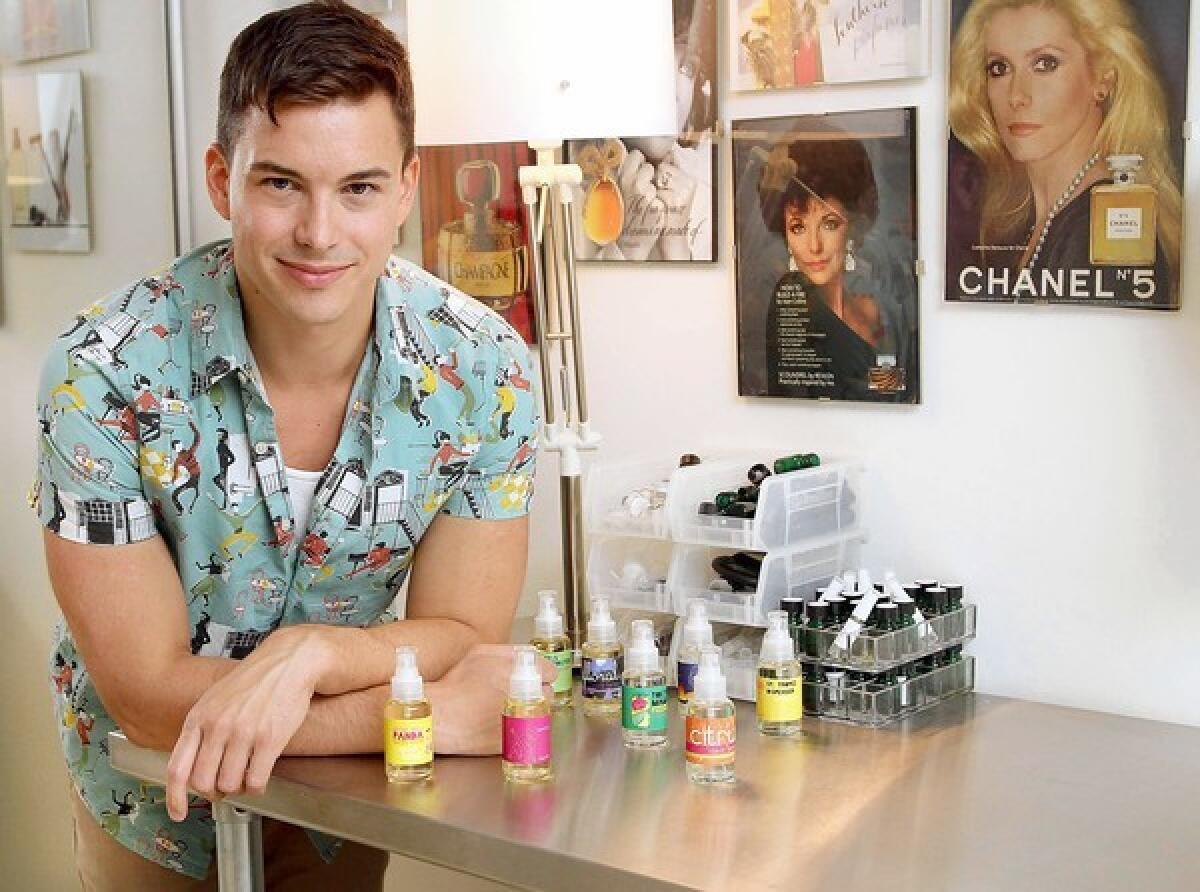Indie perfumers finding sweet scent of success

Brent Leonesio of West Hollywood became a perfumisto at age 12 when his mother bought him a bottle of Hermes’ Eau D’Orange Vert. He was astonished at how the perfumer had captured the scent of a real orange.
But it wasn’t until he was an adult and in the process of being laid off as a buyer for a high-end retail store that Leonesio decided to parlay his unemployment checks into perfumery. Ordering raw materials and technical books online, he began to teach himself the ancient art.
In 2009, Leonesio launched Smell Bent, relying on a colorful website, word-of-mouth and modest prices (most bottles are less than $50) to spur sales. Three years later, Smell Bent makes almost 40 fragrances, including the whimsically named Prairie Nymph (notes of honey, carnation, clementine, beeswax) and Hungry Hungry Hippies (chocolate, patchouli and cannabis), and Leonesio is a full-time perfumer.
His sales are minuscule in the context of the industry as a whole ($2.8 billion in 2011, according to market research firm NPD Group). Nonetheless, Smell Bent is one of more than 20 independent perfumers flourishing in California, most of whom ply their trade far from shopping malls where designer perfumes rule the beauty roost.
Some indies apprentice with master perfumers, at apothecary shops or with big fragrance firms. Others are steeped in aromatherapy. Still others are self-taught. Some use only botanical ingredients.
But even those using aroma chemicals usually include more natural ingredients than do their mass market cousins. They are obsessive about sourcing raw materials (such as oud, sandalwood and ambergris), mixing in small batches and following their creative bliss — through their noses. Lacking big budgets for models, ads and fancy bottles, they focus on the juice.
“The goal of my perfume was always to put the money inside the bottle rather than outside,” Leonesio says.
The explosion in indie perfumery illustrates a desire for the handmade in an increasingly mass-produced world.
In July, hundreds of people flocked to an Artisan Fragrance Salon in San Francisco, where 20 small perfumers showcased their wares. The sniffapalooza included olfactory “tastings,” fragrance launches, book signings, panels. and, of course, much sniffing and buying.
.
The fragrance renaissance owes much to the Internet, which has allowed small producers to sell worldwide.
But even bricks-and-mortar stores are expanding. Scent Bar, the well-known boutique that stocks niche, artisanal and cutting-edge perfumes, just moved to a new Beverly Boulevard location that is almost triple its original 300-square-foot space.
And New York niche firm Le Labo has opened a second L.A. store, this one next to Strange Invisible Perfumes, Alexandra Balahoutis’ organic botanical perfumery in Venice.
Need more evidence of the indie trend? This year, the Fragrance Foundation, which hosts the annual FiFi awards — the Oscars of the perfume world — added an independent perfumer category. And the Internet hums with blogs that review fragrances, interview perfumers and host projects to create fragrances inspired by a painting, a poem or a piece of music.
This might not attract giants like Coty or Dolce & Gabbana, but it piques the interest of indies, whose size gives them flexibility and spontaneity.
Cross-pollination is a key to success. Leonesio has teamed up with Luckyscent to create a limited-edition fragrance for hard-core oud enthusiasts. Mandy Aftel of Aftelier Perfumes in Berkeley collaborates with Bay Area chefs to host scented dinners in which each course is paired with a perfume. Kedra Hart, proprietor of glamorous Opus Oils in Hollywood, launched the Burlesque Collection after designing a signature scent for exotic dancer Satan’s Angel. And Roxana Villa of Roxana Illuminated donates a percentage of profits from her perfume Q (inspired by the majestic California oaks around her Woodland Hills home and featuring notes of oak, bergamot and resins) to the California Oaks Foundation.
In addition to perfume, many indies make scented bath products, candles, incense, teas and chocolate. They design custom fragrances and will visit your wedding or birthday party and put on “scented events.” Many teach workshops about raw materials that culminate with attendees designing their own perfumes.
They use the Internet to great effect. When you buy San Francisco perfumer Ineke’s sampler set for $25, you receive a $25 credit toward a full bottle of your choice. Sarah Horowitz Parfums in Westlake Village will send three free samples in return for “liking” her Facebook site.
“I’ve had a website since 1995, and 70% of my retail orders come in online,” says Horowitz, who began designing custom fragrances in college while working at a Boston apothecary-style perfumery and later created a scent for Fred Segal’s Apothia, the delicate citrus floral musk If.
Horowitz also started her own firm and cajoled people at the notoriously secretive fragrance houses to introduce her to their perfumers. Eventually, Mane USA, one of the big seven fragrance firms worldwide, allowed her to do a one-week apprenticeship with perfumer Jim Schmitt.
“I was obsessed. I read everything I could. But this art form chose me. It felt like this was what I was supposed to do with my life,” she says.
Many indie perfumers also “ghost” perfumes for companies, a growing niche since firms like Gap, Urban Decay and even Whole Foods now sell branded fragrances. Beverly Hills perfumer Keiko Mecheri created a line of private-label room sprays and candles for Ralph Lauren Home and the Takashimaya New York department store. She launched her own firm in 1997 and now sells 50 upscale perfumes, including bestseller Loukhoum (named after the sweet Turkish candy), the Bespoke collection and St. Tropez-inspired Un Jour d’Ete.
Says Bay Area perfumer Yosh Han: “When I first started my company, Europeans couldn’t even fathom the thought of a non-French or non-Italian perfume brand. Now there’s great attention to niche American perfumery because there are so many talented creators here.”



